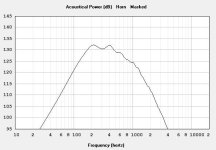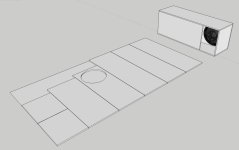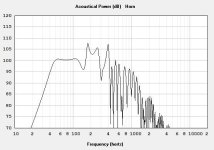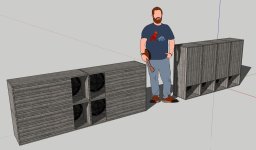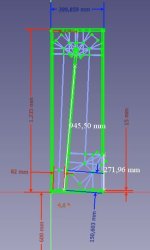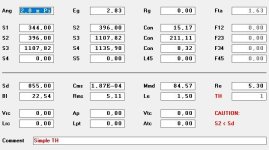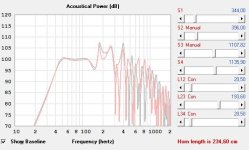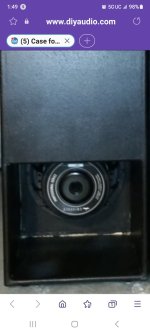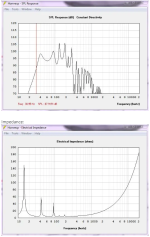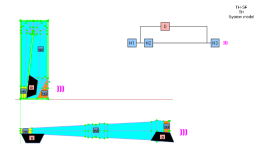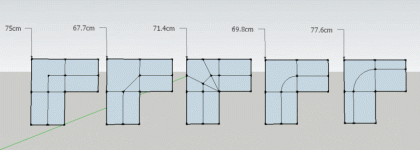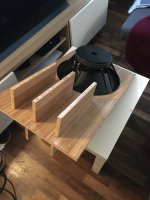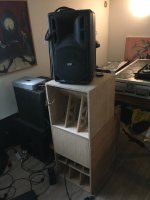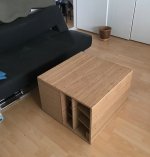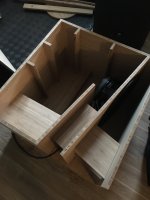Very informative. Thanks 🙂
I did a quick sim of the very popular MT-130 mid/top, It quickly looses efficiency below 200hz. My Bill Fitzmaurice Jack12 is quite similar. Hopefully the Manifold can fill that 100-200hz kick duty and save me building kick cabs and running a 4-way system.
I did a quick sim of the very popular MT-130 mid/top, It quickly looses efficiency below 200hz. My Bill Fitzmaurice Jack12 is quite similar. Hopefully the Manifold can fill that 100-200hz kick duty and save me building kick cabs and running a 4-way system.
Attachments
I did a quick sim of the very popular MT-130 mid/top, It quickly looses efficiency below 200hz. My Bill Fitzmaurice Jack12 is quite similar. Hopefully the Manifold can fill that 100-200hz kick duty and save me building kick cabs and running a 4-way system.
Take a look on the design below, maybe it interests you. Don't know if size fit your needs, but efficiency wise, it's good. 102dB @,28v/1m from 120Hz to 1kHz.
Freddi built one and post measurements and feedbacks inside the thread.
Post #11
Simpler is better.
Hello Fredi,
I've been playing around with model to get the best output possible from my 10" speaker Snake ESX310, and I reached the attached design that may fit your needs. I has only one bend easy to round.
Total volume: 94L
External dimensions:
Width: 31cm
Height: 58,6cm
Depth: 50cm
I choose dimensions to better fit on top of my Tapped Horn. I also have a 122L version that goes little lower. I'm still thinking witch one I'm going to build in near future. You can easily tune the dimensions to your needs.
Attached FreeCAD model zipped and Hornresp...
Is wider useable range not always a good thing? You can always cross at 100hz if you want to. Do you think it will sound bad over 150hz? Or do you just not see the point in going that high? I find lots of mids run into excursion issues, when run at full power down to 100hz. Crossing higher can often remedy that.
Well, midbasses are designed to play midbass. I'm not going make a driver do what it is not intended to do.
Now SQ guys in car audio will low pass subs at 200hz when they are mounted in the front of the vehicle. 9 out of 10, the drivers are mounted in sealed enclosures.
I’d try it, the moving mass of 15ndl76 is quite low (will have slap/dynamics for kick-Range) and the higher you cross your subs to tops the more efficient your system will be.. most of the energy requirements in music is below 200hz. If you let the subs handle that efficiently then your top section doesn’t need to have as much power and or efficiency. Keen to see how your project turns out! I also want to try comparing my 12ndl76 in tapped horn and bandpass config.
I like these ‘manifold’ ideas that don’t use pipes, like paraflex’ that run into full wavelength cancelation issues between multiple resonances and (maybe) not so much ringing??
Also seems to take up less volume for the same SPL. I really don’t get the whole paraflex rage at the moment. I might build one, to do side by side comparison with same volume and driver. Would be a fun experiment.I like these ‘manifold’ ideas that don’t use pipes, like paraflex’ that run into full wavelength cancelation issues between multiple resonances and (maybe) not so much ringing??
I like the simplicity of a TH.
A single fold TH has the same amount of pieces (7) as a BR enclosure.
A single fold TH has the same amount of pieces (7) as a BR enclosure.
I agree, the minimalist TH is very nice, if the dimensions suit your needs. If you make a Tham15 in this fold, you get a box that is 40x40x117cm. To get to 40hz, it would need to be even longer. That is a very awkward size for my use, as it won't fit on my cargo bike. But for some people, this might be the perfect shape to fit in a corner or under a couch. In that case the TH probably wins for simplicity and ease of driver access.I like the simplicity of a TH.
A single fold TH has the same amount of pieces (7) as a BR enclosure.
I just realized the 15" driver won't fit in that box 😆 also that is internal dimensions. This makes the external dimensions even more awkward at 40x45x119. I'm not even sure that it could stand up on it's own without falling over. I guess one could increase the horn flare and get slightly more efficiency, but then the box starts getting pretty big.Tham15 in this fold, you get a box that is 40x40x117cm.
I agree, the minimalist TH is very nice, if the dimensions suit your needs. If you make a Tham15 in this fold, you get a box that is 40x40x117cm. To get to 40hz, it would need to be even longer. That is a very awkward size for my use, as it won't fit on my cargo bike. But for some people, this might be the perfect shape to fit in a corner or under a couch. In that case the TH probably wins for simplicity and ease of driver access.
I'm a MTH-Alternate fold type of guy. It's all about simplicity for me.
You inspired me to do a quick design, I don't want to build it, but maybe someone finds it useful. I again used the 15NDL76 driver.I like the simplicity of a TH.
A single fold TH has the same amount of pieces (7) as a BR enclosure.
the cabs are a bit awkward to stack, but if you like building walls, this is for you.
Link to sketchup model:
https://app.sketchup.com/share/tc/n...DIeEMYuYT59vOfv55WWRaN7oX7qfKmnRlN&source=web
Attachments
How does L34 = 8.32cm for a 15" driver? If anything, L12 and L34 should be around 20.32cm (8").
Haaa,
that one resemble the 12" TH called the PAL12 made by mRgSr
but the PAL12 have more folds inside thus hit a little lower
Operating frequency: 34Hz----120Hz +/-3db
Dimensions: 30"x38"x15"
Impedance: 4 ohms
Power handling: 400w rms, 800w program High pass 32Hz 24db/octave minimum
Original thread here











that one resemble the 12" TH called the PAL12 made by mRgSr
but the PAL12 have more folds inside thus hit a little lower
Operating frequency: 34Hz----120Hz +/-3db
Dimensions: 30"x38"x15"
Impedance: 4 ohms
Power handling: 400w rms, 800w program High pass 32Hz 24db/octave minimum
Original thread here
There aren't many 12" tapped horns for prosound. The Lab 12 is a great driver for the price, has a strong cone for tapped horn high(ish) compression ratios, and a good amount of Xmax.
12" tapped horns can be much skinnier than 15" and 18" horns, and with the price of the Lab 12 ($165) one can use 4-8 horns and not hurt the wallet too much.
With multiple horns as opposed to one or two large 18" horns, you have more options for stacking and setup.
Figure with the 400w rms rating of the driver, huge amps aren't needed to drive the cabinets to full output.
So here is the breakdown...
12" tapped horns can be much skinnier than 15" and 18" horns, and with the price of the Lab 12 ($165) one can use 4-8 horns and not hurt the wallet too much.
With multiple horns as opposed to one or two large 18" horns, you have more options for stacking and setup.
Figure with the 400w rms rating of the driver, huge amps aren't needed to drive the cabinets to full output.
So here is the breakdown...
- m R g S r
- Replies: 866
- Forum: Subwoofers
L12 can't be changed in @LORDSANSUI's model for some reason.How does L34 = 8.32cm for a 15" driver? If anything, L12 and L34 should be around 20.32cm (8").
I don't know why L34 is shorter than L12? Maybe something to do with the driver being positioned in the last fold?
I used @LORDSANSUI's model to calculate the folds, maybe he can chime in here? 🙂
It doesn't really make a big difference to the sim, so that's why I didn't bother to fix it.
Attachments
Pal12 yes is a 12"My fault, I'm still thinking 15" driver when that's a 12" driver.
Nesral is 15" (15ndl76) BC
Awkward Noise maker. Easy to do ‘better’ if playing around with the ‘manifold’ (6th parallel bp) idea? It goes ‘silent’ at the top of the bandwidth
(I think I’m more concerned with potential ‘ringing’ at one of those locations where the ‘horn’ shape is suppose to be filing in full wave cancelation freqs that would exist in a ‘pipe’ shape? It’s all so strange to listen to
(I think I’m more concerned with potential ‘ringing’ at one of those locations where the ‘horn’ shape is suppose to be filing in full wave cancelation freqs that would exist in a ‘pipe’ shape? It’s all so strange to listen to
Attachments
Last edited:
L12 can't be changed in @LORDSANSUI's model for some reason.
I don't know why L34 is shorter than L12? Maybe something to do with the driver being positioned in the last fold?
To better understand the reason you need to look to the TH-SF System Model.
The first segment H1 (yellow colored), has the L12 defined by the throat at dead end and mouth at center of drivers placement.
The segment H3 (orange colored) has the L34 also defined by the throat center of drivers placement and mouth and box exit hole.
To improve accuracy in the model you need to guarantee the right placement of the driver and corresponding input data for hornresp. Consider that for this model the driver is placed in a section where the horn is folded, so I took one of the nodes of the "advanced centerline method" as a reference to link driver placement, so the model runs full automated.
For who knows CAD very well, it's easy to break this link and change driver position, but you will need to change many other things, I don't think it worth the effort.
I'm attaching an image regarding different ways to fold the horn and you will see that the length is affects. Members of DIY in the past made a lot of comparison between simulations and measurements witch results on the advanced center line being the better method to fold a horn and define its length. in the picture it's the size 71.4 and it has 4 nodes in the center line.
Attachments
So I got the prototype put together. Did some quick tests without glue, damping, or bracing and with a random no name driver (took it out of a BR sub, with about the same tuning, so should be about right). It sounded pretty damn good. Obviously rattling at high SPL, due to the above issues. Good sound from 45-140hz and a little spikey from 150-300hz.
The rising response is pretty audible, but should disappear when four cabs are V-plated and for single cab use, the midbass can be EQ’ed down.
Very nice when crossed to a kick @120hz, to get the chest pressure up to a good height and avoid those higher resonances.
It can be nicely disguised as a coffee table to keep the missus happy ❤️
The rising response is pretty audible, but should disappear when four cabs are V-plated and for single cab use, the midbass can be EQ’ed down.
Very nice when crossed to a kick @120hz, to get the chest pressure up to a good height and avoid those higher resonances.
It can be nicely disguised as a coffee table to keep the missus happy ❤️
Attachments
- Home
- Loudspeakers
- Subwoofers
- Case for Discussion - Would a Single driver Manifold/MTB be better than Tapped Horn?
